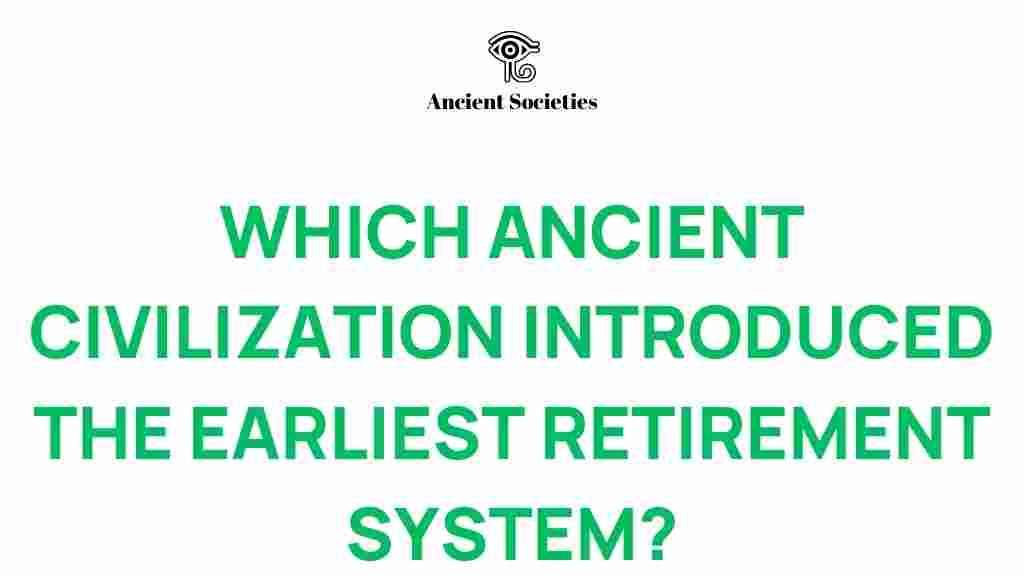Unveiling the Secrets of the First Retirement System in History
The concept of a retirement system is often associated with modern economic structures, but the roots of social welfare can be traced back to ancient civilizations. In this article, we will explore the fascinating history of retirement systems, uncovering how ancient societies laid the groundwork for pensions and economic stability. We will also delve into the archaeological findings that reveal the cultural heritage of these systems and their impact on the workforce.
The Origins of Retirement Systems in Ancient Civilizations
Retirement systems are not just a modern invention; they have ancient origins. Several ancient civilizations developed concepts of social welfare and support for their aging populations, recognizing the need for economic stability and care for those who had contributed to society throughout their working lives.
- Mesopotamia: The Sumerians and Babylonians had systems in place where priests and government officials received stipends in their old age.
- Ancient Rome: Roman soldiers were granted pensions after years of service, ensuring their economic stability as they aged.
- China: Confucian philosophy emphasized respect for elders, leading to systems where families were expected to care for their aged members.
The Role of Archaeology in Understanding Retirement Systems
Archaeological findings play a crucial role in uncovering the retirement systems of ancient civilizations. Excavations and studies of artifacts provide insights into how these societies functioned and how they supported their elderly populations.
For instance, in ancient Roman sites, inscriptions have been found that document pension arrangements for retired soldiers. These findings highlight the formalization of a retirement system that recognized the contributions of individuals to society.
Social Welfare and Economic Stability in Ancient Times
The development of retirement systems was closely linked to the broader concepts of social welfare in ancient civilizations. Here’s how these systems contributed to economic stability:
- Support for the Elderly: Providing pensions ensured that the elderly could live without financial hardship.
- Encouragement of Workforce Participation: Knowing there was a safety net for the future allowed individuals to contribute to the workforce without fear of destitution in old age.
- Strengthening Community Bonds: Retirement systems promoted a sense of responsibility among younger generations towards their elders.
How Ancient Civilizations Established Their Retirement Systems
Establishing a retirement system in ancient civilizations involved several steps:
- Recognition of Aging Population: Societies had to acknowledge the increasing number of elderly individuals as life expectancy improved.
- Development of Contribution Models: Many civilizations introduced systems where individuals contributed to a communal pool, which would later fund pensions.
- Legal Framework: The establishment of laws to protect the rights of the elderly and ensure they received their due pensions was crucial.
- Community Involvement: Engaging the community in caring for the elderly established a culture of respect and support for aging individuals.
Challenges Faced by Ancient Retirement Systems
Despite the progressive nature of these systems, ancient retirement systems faced several challenges:
- Economic Instability: Wars and plagues could disrupt funding for pensions.
- Social Changes: The rise and fall of empires often led to changes in the structure of retirement systems.
- Population Growth: An increasing elderly population could strain resources and support systems.
Lessons from Ancient Retirement Systems for Modern Society
As we analyze the first retirement systems in history, several lessons emerge that can inform contemporary social welfare programs:
- Importance of Legal Protections: Just as ancient societies established laws to protect their elderly, modern systems must ensure legal frameworks are robust.
- Community Responsibility: Engaging communities in the welfare of their elderly can foster a caring environment.
- Adaptability: Just as ancient systems adapted to changing circumstances, modern systems must remain flexible to evolving economic conditions.
Conclusion
The exploration of the ancient civilization’s retirement systems reveals a rich tapestry of social welfare practices that laid the groundwork for modern pensions. Through archaeology and historical analysis, we uncover the importance of caring for our aging populations, a principle that transcends time. The lessons learned from these early systems not only enhance our understanding of cultural heritage but also guide us in creating sustainable and effective social welfare programs today.
For more insights into the evolution of social welfare, visit this resource. To delve deeper into archaeological studies that illuminate our past, check out this article.
This article is in the category History and created by AncientSocieties Team
